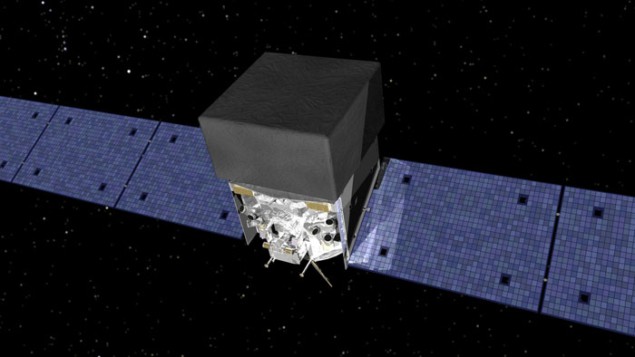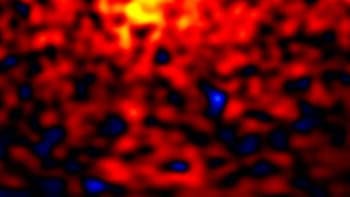
New results from NASA’s Fermi Gamma-Ray Space Telescope appear to confirm a larger-than-expected rate of high-energy positrons reaching the Earth from outer space. This anomaly in the cosmic-ray flux was first observed by the Italian-led PAMELA spacecraft in 2008 and suggests the existence of annihilating dark-matter particles.
Physicists believe that about 80% of the mass in the universe is in the form of a mysterious substance known as dark matter. Unable to observe dark matter using light or other forms of electromagnetic radiation, researchers are attempting to find direct evidence of it on Earth using either heavily shielded underground detectors or with particle accelerators. But they also have a third, less direct, option – using satellites or balloon-based instruments to detect the particles that some theories predict are created in space when two dark-matter particles collide and annihilate.
The Payload for Antimatter Matter Exploration and Light-nuclei Astrophysics (PAMELA) mission caused excitement in 2008 after it found significantly larger numbers of positrons (anti-electrons) at energies 10–100 GeV than expected. Taking into consideration only positrons produced when protons interact with the interstellar medium, physicists had calculated that at higher energies there should be a gradual drop in the number of positrons reaching the Earth. However, dark-matter collisions are expected to produce equal numbers of electrons and positrons over a given energy range. This would boost the ratio of positrons to electrons detected because positrons are substantially less abundant than electrons in the universe as a whole.
Positrons or protons?
The PAMELA results, however, were not watertight, mainly because of the possibility that the mission was confusing positrons with the far larger numbers of protons reaching its detectors. But the latest results from Fermi appear to remove these doubts. Although it is a gamma-ray telescope, Fermi in fact works by detecting electron–positron pairs and so is also well suited to studying cosmic rays. Unlike PAMELA it does not include a magnet to distinguish between electrons and positrons, but the Fermi scientists realized they could use the Earth’s magnetic field instead. This bends electrons and positrons in such a way that certain patches of the sky will contain just one kind of particle but not the other. So by totting up the signals coming from these regions, the researchers were able to separately measure the electron and positron fluxes, and hence work out the fraction caused solely by the latter.
The team observed a significant increase in the positron fraction at higher energies. This coincides with the PAMELA results, to within the errors on the Fermi measurements. The results of this analysis were presented at a conference in Rome last week by Fermi collaboration member Warit Mitthumsiri. Mitthumsiri’s colleague Stefan Funk of the SLAC National Accelerator Laboratory in California believes that the results constitute “a very nice confirmation” of the observations from three years ago, and maintains that the background noise has been properly accounted for. “There will be a small fraction of protons that will look like electrons,” he says, “but we are quite positive that we have subtracted that fraction correctly.”
PAMELA’s principal investigator, Piergiorgio Picozza of the University of Rome Tor Vergata, agrees. He says that, barring some unknown source of protons, the Fermi results “strongly support the positron excess at higher energy”, adding that the agreement is all the more compelling because the two data sets were derived using “different analysis, different detectors, and completely different experimental conditions”.
We can confirm the PAMELA result but it is still puzzling where these additional positrons come from Stefan Funk, SLAC
However, even if the results themselves are now on a firmer footing, their interpretation is still open to debate. In principle, the positron excess could point to a misunderstanding in how protons interact with the interstellar medium, but Funk believes that it is unlikely. What is more likely, he says, is the existence of some other, primary, source of positrons, but that could be either annihilating dark-matter particles or some more mundane astrophysical process, such as acceleration by pulsars. “We can confirm the PAMELA result,” he explains, “”but it is still puzzling where these additional positrons come from.”
AMS or Planck could provide answers
John Wefel, an experimental astrophysicist at Louisiana State University in the US, believes that the Alpha Magnetic Spectrometer (AMS) could help to establish what is causing the excess. The AMS has just become operational on the International Space Station and Wefel points out that it has a more powerful magnet than PAMELA and will therefore be able to probe positron fluxes at higher energies. “What AMS ‘sees’ may be very important in deciding between different models,” he says.
Neal Weiner of New York University believes instead that NASA’s Planck mission might provide the answer; he argues that if the positron excess really is due to dark-matter annihilation, then that annihilation should alter the cosmic microwave background. “Some people will jump and say this is clearly dark matter, and some will dismiss this as messy astrophysics,” he says. “But I think both reactions miss the point. This is science after all, so no-one’s gut feeling is really the question – we simply need more data, and we shall have more data.”



